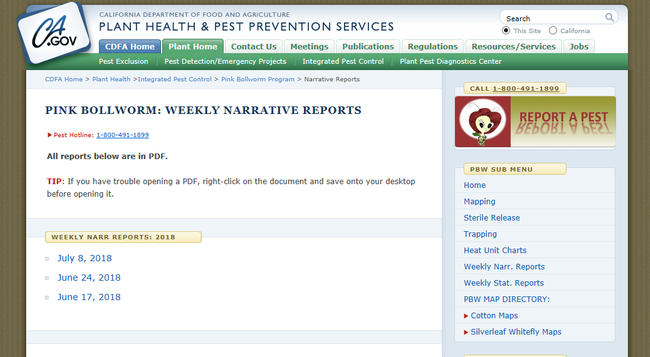Cotton lint stickiness is a significant problem, worldwide. It is also an issue here in California, and a major focus of attention for cotton growers and ginners in the state. Sticky cotton loads can physically slow down the processing speeds of gins, even to the point of shut down. Stickiness may necessitate the special handling of contaminated bales, which can result in increased costs. The milling process can also be affected by stickiness, as work stoppages may be required to clean combs and rollers. Millers may choose to blend sticky fibers with clean ones as a way to mitigate the situation or they may elect to engage with different cotton merchants altogether in order to avoid persistent problems.
While free plant sugars (from immature fibers) can contribute to stickiness, most lint contamination results from honeydew, a sugar-rich liquid that is excreted by sap-sucking insects such as sweet potato whiteflies (Bemisia tabaci) and cotton aphids (Aphis gossypii). For more information about identifying whiteflies in Central Valley cotton, please visit this web page: http://cottoninfo.ucdavis.edu/files/133231.pdf. Droplets of honeydew can be deposited onto open bolls from these pests as they feed on the cotton plant; it is these sticky secretions that cause lint to adhere to metal surfaces throughout the harvesting, ginning, and milling process. Don't underestimate the amounts of honeydew that can be produced...results from a study conducted in 1999 (Henneberry et al, Southwestern Entomologist 24:207-231) found that each adult sweet potato whitefly feeding on cotton could excrete between 25 and 64 droplets of honeydew, every day.
The California Department of Food and Agriculture's (CDFA) Plant Health and Pest Prevention Service began their whitefly monitoring program on July 2, 2018. CDFA personnel from the Pink Bollworm Program will be regularly evaluating cotton leaf samples from pre-selected screening sites, located in 10% of all cotton fields in each county in the San Joaquin Valley, to describe changes in whitefly numbers over space and time. Reports will be posted beginning July 16th at the CDFA Pink Bollworm web page: https://www.cdfa.ca.gov/plant/ipc/pinkbollworm/pbw_hp.htm
Whitefly monitoring reports will be compiled and released by the Pink Bollworm Program.
For more information about whitefly biology and management in cotton, please visit the following University of websites: http://cottoninfo.ucdavis.edu/files/133231.pdf and http://ipm.ucanr.edu/PMG/r114300311.html, or contact the UC Cooperative Extension office. Cotton aphid control guidelines can be accessed at: http://ipm.ucanr.edu/PMG/r114300111.html. Stickiness doesn't have to be a part of California cotton production. The monitoring and management of the primary pests responsible for sticky cotton (as well as their alternate, weedy hosts, like field bindweed (Convolvulus arvensis) and black nightshade (Solanum nigrum)) can help prevent reductions in both lint yield and quality.
